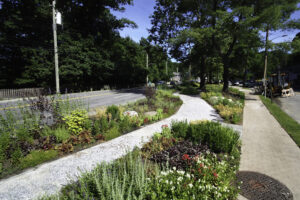While politicians and the media have spent the summer and early fall focused on Congressional consideration of massive Federal infrastructure and budget bills, funding from the American Rescue Plan Act (ARPA), passed by Congress in March 2021, has slowly made its way into local government coffers, where it is available to use on a range of pandemic-related projects specified in ARPA.
Distribution of the Rescue Plan money differs significantly from previous Congressional bailout bills, such as the $2.2 trillion Cares Act, passed by Congress in March 2020.
Previous pandemic stimulus bills relied on state governments to handle distribution of funds to other government entities. The Rescue Plan included provisions that funneled funding directly to counties, cities, towns and villages without state government input into decisions about how that money would be spent.
“This was really a revolutionary change,” said Croton-on-Hudson Village Trustee Len Simon, who spent many years representing the U.S. Conference of Mayors and local governments in the halls of Congress. “Unlike past stimulus bills, Rescue Plan funding is not filtered through the priorities of state governments. Instead, local governments can make decisions that reflect their judgment about the best use of those funds.”
****
The permitted uses of ARPA funds are for …
* costs associated with responding to the pandemic
* supporting essential workers
* covering revenue losses caused by Covid-19
* making necessary infrastructure investments
The National League of Cities surveyed local governments (towns, cities, and counties) about their plans for ARPA spending. It found that infrastructure projects, particularly for water and sewer systems, and, to a lesser extent, broadband expansion, were a top priority for 84% of governments responding to the survey.
Replacing lost public sector revenue was cited by 51% of respondents, followed by addressing negative impacts of the pandemic (37%), public health expenditures (27%), and supplementing pay for essential workers (23%).
CORTLANDT

The Town of Cortlandt was allocated $4.64 million in ARPA funds to be used over two years. The Town was required to redirect a portion of that allocation to the two villages in its jurisdiction, Buchanan and Croton-on-Hudson, leaving the Town with $3.2 million. Cortlandt intends to apply the funding to advance economic development plans that are already underway.
Supervisor-elect Richard Becker said Cortlandt will use ARPA funds primarily for infrastructure. For example, the Verplanck Waterfront Revitalization Project, initiated in response to the closing of the Indian Point Nuclear Power Plant, will receive funding to create roads and expand utilities for development of 120 acres by the Town. A committee of 20 Cortlandt residents is guiding the project and will make recommendations about specific expenditures.

***
Other Cortlandt infrastructure projects slated for ARPA funding include the design of storm sewers in the Annsville Circle area and along Route 9 near Montrose, another area affected by the closure of Indian Point.
Becker, who has been involved in these projects as a member of the Town Board, further explained, “Together with grants from the State of New York, as well as other Federal grants, we are optimistic we can complete these projects to ensure economic stability and to attain the goals of the Town’s 10-Year Master Plan.”
CROTON-ON-HUDSON

Located in the Town of Cortlandt, the Village of Croton-on-Hudson received about $823,000 in ARPA funds, half of which showed up in the Village bank account in August. (The other half is due to arrive in summer 2022.)
The Croton coffers were hit particularly hard by the pandemic shutdown, since around 20% of the Village budget depended on revenue from its 2,000-space parking facility at the Croton Harmon Metro North train station.
***
Village Manager Bryan Healy said that “due to revenue losses at the train station parking lot, projected to be in excess of $1.5 million this year, compared to 2019, we have allocated all our funds towards replacing that revenue.”
Healy added that “the Village Treasurer has reviewed the guidance from the [U.S.] Treasury Department and taken part in a seminar offered by the New York Conference of Mayors to ensure our reporting is done correctly.”
BUCHANAN
The Village of Buchanan, also located in the Town of Cortlandt, is another jurisdiction facing severe economic challenges as a result of the closure of Indian Point. The village received $200,000 in ARPA funding, according to Village Administrator Marcus Serrano, The Village Board authorized the use of the funds for Wastewater infrastructure designed to meet Department of Environmental Conservation (DEC) requirements.
TOWN OF OSSINING

Although the Town of Ossining received $4.14 million in funding, ARPA required that most of that allocation be re-distributed to the two populous villages located in the Town: Briarcliff Manor and Village of Ossining. The Town was left with $586,000, reported Ossining Supervisor Dana Levenberg.
Levenberg said that the Town conducted two public hearings on plans for the ARPA funds. The Town Board voted to contribute $100,000 to the Ossining Volunteer Ambulance Corps to support Covid-19 testing by the agency. They also anticipate allocating approximately $40,000 to the general operating fund to make up for pandemic related loss of revenue.
“It is our understanding that we have until 2024 to obligate the funds and until 2026 to spend the funds, so we have not yet finalized the full plan,” Levenberg told River Journal North. “We are hoping to put the remaining $300,000 toward sewer infrastructure and are still exploring how we can do that to meet the goals of ARPA.”
“We also anticipate needing to spend approximately $5,000-$8,000 on our auditors to make sure our expenditures were made in compliance with federal requirements.”
VILLAGE OF OSSINING
Rika Levin, the Mayor of the Village of Ossining, which received $2.54 million in ARPA funds, said the Village is “in the process of evaluating the most efficient and effective opportunities to disburse these funds on behalf of the Village of Ossining’s 27,000 residents … to fund future projects for a broad range of categories.”
Specific projects the Village is considering include reconstruction of its water plant, improvements to the Community Center, and post-pandemic reconfiguration of some infrastructure at Village parks.
BRIARCLIFF MANOR
Briarcliff Manor received around $830,000 in ARPA funding, according to Village Treasurer Kathryn Nivins. “The Village Manager and Board of Trustees are exploring the various options as per Federal ARPA rules and regulations,” she explained.
“There have been recent changes to the restrictive uses, which are now a little more flexible,” Nivins continue. “That has expanded the potential opportunities for the Village.”
[14pt BF sub-hed]
PEEKSKILL
The City of Peekskill was allocated $2.45 million in ARPA funding. City Manager Andy Stewart said that the City Council determined that the first need was the revenue shortfall due to the pandemic. The City lost revenue of approximately $2.5 million compared to the revenue budgeted for 2020.
“The second need,” said Stewart, “is to address deferred spending on infrastructure due to the postponement of spending during 2020 and 2021, when the city adjusted its budgets in line with the lost revenues and increased spending due to Covid.
“The City is moving forward with a range of capital projects to improve the water system, including water lines, valves, hydrants and the replacement of an old water storage tower.”
The City also prioritized two social issues for possible support with ARPA funds: vaccination promotion and eviction prevention, initially allocating $50,000 to promote Covid-19 vaccination, especially for non-English speakers.
That project is currently on hold as the City’s vaccination rate has surpassed 80%, active Covid cases remain low, and other agencies are effectively promoting vaccination programs, both for children and for booster shots.
The Peekskill Common Council approved the hiring of independent auditors to provide guidance on compliance with ARPA funding guidelines.
***
Stewart said of the ARPA program, “The City is grateful for this federal support and sees the program as well designed for efficient implementation at the local level. The focus on infrastructure is appropriate for a historic Hudson River valley city with aging water, sewer and drainage pipes and systems.
“A recent infrastructure report estimated the City will need to spend $80 million-$100 million on infrastructure in the coming years,” Stewart added. “Obviously, as grateful as we are for the ARPA funding, the infrastructure project costs far exceed the funds made available by the ARPA.”
***
At about $100 per resident, ARPA funding to local jurisdictions is dwarfed by earlier Federal programs to address the economic effects of the Covid-19 pandemic, such as enhanced unemployment benefits, the Paycheck Protection Program (PPP), or the direct payments totaling more than $2,000 that most Americans received.
Some larger Hudson Valley jurisdictions, such as the cities of Poughkeepsie, which received over $20 million in ARPA funds, and Kingston ($17 million) sought formal public input in developing their plans for the use of ARPA funds. Both jurisdictions also set up websites to track ARPA expenditures.
“It is true that many larger jurisdictions, because they received significantly greater funding than smaller ones, adopted a more formal public engagement process to determine how best to spend their ARPA dollars,” said Croton’s Len Simon.
“Our Village Board gathered public input through its annual budget process, where citizen involvement is always considerable. In that way, we made decisions about ARPA funds in the context of how all our budgeted expenditures can be used to benefit all of Croton.
“But whether its ARPA, the new Infrastructure Act, or the hoped-for Build Back Better program,” added Simon, “it is incumbent on local governments of every size to be as transparent as possible, if we are to win public support for this sort of investment in the future.”
The ability of New York’s smaller cities, towns, and villages to make effective use of ARPA funding will affect how the country evaluates the Federal response to the Covid-19 pandemic. It also remains to be seen whether the American Rescue Plan Act’s direct allocation of funds to local governments will become more common.
Rob Abbot is a retired schoolteacher who lives in Croton-on-Hudson.
Mackey Landy is a filmmaker and political researcher who lives in Brooklyn.







The Town of Cortlandt has a ten year structural deficit in their budget…. they spend more than revenue coming in. How are they addressing this problem… they have not done so yet.